Shashi is the senior vice president of Search products at Yahoo!, responsible for leading the company’s efforts to invent a next-generation search experience.
Shashi has deep expertise in the Internet and Search industries, having held leadership positions at Google, eBay, and AOL. Prior to his role with Yahoo!, he was the senior vice president of advertising products and search, and was Chief Revenue Officer at Cooliris. As the head of monetization for YouTube at Google, Shashi was responsible for building advertising products, exploring all monetization opportunities, and defining business models. At Google, Shashi was the product lead for Search and managed the web search, search personalization, and community-based search. He also built and launched Google’s Custom Search Engine product. During his time at eBay, he created and implemented the company’s innovation and platform strategies.
Shashi holds over two dozen patents and sits on the board of advisors of Ustream, Scribd, Jivox, and BloomReach. He received an MS in Computer Science from the University of Poona and studied Computer Science at the University of Miami.
Interview Transcript
Eric Enge: Can you tell us a bit about where things are with the Yahoo! – Bing transaction?
Shashi Seth: Since the Microsoft transition approval was announced this February, we have been busy working on the integration. And, that project is well underway with lots of internal testing going on as we speak, and we have been testing their index and ranking in our environment for a couple of weeks now. Things are looking good, and our goal is to be able to complete the migration sometime before the holidays.
Eric Enge: From what I’ve seen it looks like a phased rollout.
Shashi Seth: It is being done in two phases. Our first priority is to make sure that the algorithmic side transitions over with quality. We have a set of metrics in place with Microsoft to assess what it takes to migrate over a certain country and what the quality measures are.
The testing that has begun looks at those metrics carefully to tweak the different elements and parameters. Once we are comfortable on both sides, we will pull the trigger and do the transition. Soon after that, we would do the same for the sponsored search side. These efforts are happening in parallel with two separate dedicated teams for each effort. They are working hard on the task at hand, but the goal was not to push them exactly together so that everything happens in one day because that would become a very big task. Our aim is to accomplish all this before the holiday season.
Eric Enge: After the transition, if someone does an arbitrary query in Bing and the same query in Yahoo, would the search results, in principle, be identical, or are you doing some fine-tuning to make them different?
Shashi Seth: The index and ranking coverage are going to be identical. What we left open in the deal terms was what Yahoo can and cannot do with both the algorithmic and the sponsored side. Yahoo has the flexibility not only to utilize data sources from places like Twitter or our own properties, but we can also build what we call shortcuts, and other elements, and trigger them for appropriate search terms.
We have a lot of room to develop unique user experiences on Yahoo. For some sets of queries, especially the long tail of queries, there will be identical results for Bing and Yahoo, nevertheless with completely different treatments. For information with vertical intent like local or shopping, we are going to not only bring our proprietary Yahoo content to show on the search results page, but also pursuing a different and separate strategy that aims to help people get an answer quickly without wading through the blue links. That requires a lot of data in our “look aside” indexes; which we call the “web of things”. That means we source data, we extract and enrich it, and we use it to give deep insights to users for whatever they are looking for.
50% of all queries are going to receive experiences like that, but the other 50% will remain long tail and will not even trigger an ad or a shortcut. The benefit of this relationship with Microsoft is that Yahoo gets to focus on the front-end of search, look at other data sources and explore different paths, while Microsoft does the heavy lifting on the backend side.
Eric Enge: It gives Yahoo time to develop a position on what will be the higher value ad aspects of a search experience in the future.
Shashi Seth: Exactly. Essentially the backend is rapidly becoming a commodity, and we don’t need to be in that business. The analogy is if we were in the car business, we’ve outsourced the engine and are going to focus on the entire user experience for the car. Part of that strategy is determining how to win in this space, and part of the strategy is taking advantage of the fact that we have 600 million users worldwide.
In many countries and regions, such as the US, we have 80% to 85% penetration of the internet population. We have 170 million users in the US and a subset of roughly 80 million of those users use Yahoo to search. That means there are 90 million users just in the US that we can go after who are spending a considerable amount of time on Yahoo properties.
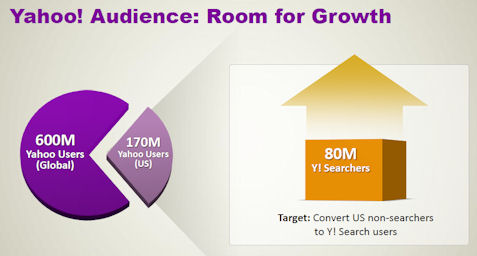 |
The goal is to get in front of them with compelling experiences that help their browsing and content discovery, turn them into searches, bring them over to the search results page, give them a great experience and over time turn them into active and engaged Yahoo searchers.
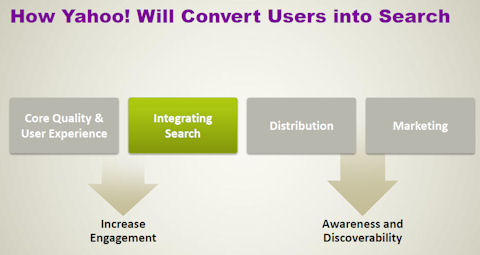 |
Eric Enge: You could say that this deal had nothing to do with Yahoo exiting the search business, but actually repositioning itself in a stronger leadership role.
Shashi Seth: That’s exactly what we are saying. We believe the user base is changing significantly. Where people are spending their time, how they are discovering content and the content they are engaging with is changing so rapidly that search needs to evolve with it. Instead of waiting for users to come to a search results page to enter a query, we need to be proactive in fulfilling their content discovery needs.
The biggest problem is all searchers have limited time. The amount of content on the web is exploding to the point where nobody even knows what exists out there. Search is going to evolve into a discovery engine to get in front of users where they are spending time and solve their core needs day-in and day-out.
Eric Enge: So essentially, by leveraging what you learn about users across all your properties, you can do a better job of anticipating their next need.
Shashi Seth: Exactly. We have started doing a lot of that. Yahoo News has both the contextual slide shows that not only target the user and their interest, but also use search as the backend technology to generate those slide shows.
We also have contextual shortcuts which underline terms that are interesting for the user. They are shown appropriately on various content pages so that when people hover on it for three seconds they get a short-end search results page on top of the content page. If the user engages with it, that’s good but if not it goes away.
We do something similar on many of our homepages with what we call trending now modules. It basically looks at the topic of a page and puts all the trending searches on top so that people can find all the trending topics in that space. These are several ways that we are starting to engage our users to bring them over to search and give them a great experience. If we can do that really well a couple of times, users will start thinking of us as the search destination to go to.
In the last two months, there was a slight uptick in our comScore numbers for the first time in 18 months. Then last month (April) the numbers shot up by 1% point because the amount of activity we can generate from 600 million users is pretty large. That shows the power of our audience base and why tapping into that resource makes a lot of sense.
Eric Enge: 1% is a pretty significant move in this game.
Shashi Seth: An interesting aspect of market share reporting is that some people carve out context-driven search efforts as a different number than traditional searches. As long as the user engages with the experience intentionally and gets search results, we believe that how it is generated shouldn’t matter.
Eric Enge: Going back to the notion of discovery and fulfilling that need. It’s not as simple as going to a specific URL, typing in a query in a specific format and getting results. It seems like it doesn’t have to be that standardized, that it could be much more distributed across various formats for interaction.
Shashi Seth: Exactly, and that’s how we are going to be successful. Now, it’s up to the industry to get together and decide what they count as searches across the board. Today what happens is comScore calls out these content-driven searches separately from people going to the search homepage and entering a query and hitting enter. While that is interesting, we don’t think that is where the industry is headed. The industry is changing significantly and needs a different way to measure overall search that is equitable for all competitors.
Eric Enge: Can you speak to the presentation that you did for your Investor Day?
Shashi Seth: That presentation was largely focused on how we see the search industry changing, how we see our users changing, and how we think search results are going to change. The work is already underway. The underlying driver is that there is so much data out there that either doesn’t exist on web pages altogether or it exists on web pages but is so deeply embedded that it is hard for anybody to extract and to assimilate it.
 |
For example, if someone was looking for which actors were in a certain movie, that is fairly easy for search engines. It becomes harder to look for slightly more complex information such as the names of all the other actors that have worked with a certain actor. It becomes even slightly more difficult to find the name of the director that has directed an actor the most often and even more arduous to find which movies brought the most money and fame to a given person.
Eric Enge: Now, you are talking structured databases.
Shashi Seth: Exactly. This information is probably embedded in snippets over hundreds of thousands or millions of documents. If somebody went to a search engine for that information, they could eventually find the answer, but people should not have to do that amount of work, given our short attention spans and limited time.
The onus is on search engines to extract this information and put it in their repository in a way that can be useful for users. This is going to be critically important and is what we call the web of things. Another example is finding dishes or menu items in restaurants rather than looking for restaurants. Instead of looking for a Greek restaurant in Palo Alto, California, someone could look for any restaurant in Palo Alto, California that has mango cheesecake on their menu.
That starts changing how people search and the landscape of search completely. That’s one big effort that we have underway and we launched this Menu Item Finder feature as one of the first efforts in that direction, but there is so much more that can be done.
We are also focusing on monetizing search differently with respect to rich ad inserts, search assist tabs, and so forth. These are really important features that advertisers are looking for because at the end of the day when an advertiser is looking to do a buy, all they care about is an audience.
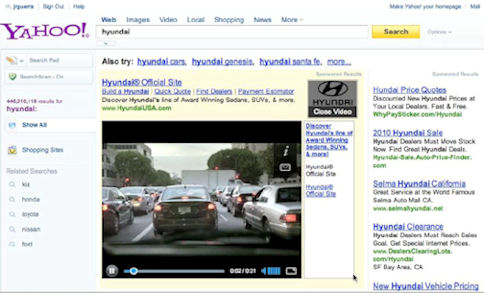 |
Those audiences can likely be found in many different places, and that is OK with advertisers as long as they can do the same demographic or psychographic targeting. We have been investing in this space for about a year and we have seen a lot of movement from advertisers.
For consumers, another new area of investment is centered on getting in front of users in a contextual manner, getting them at the right place at the right time and presenting them with experiences that fulfill their needs. The last six or seven slides walk through one use case that we are working on and planning to deploy, which is much more integrated than search experiences today.
Eric Enge: The Napa Valley Restaurants example?
 |
Shashi Seth: Yes. People spend a great deal of time on email, their personal home page, and content properties like Finance and Sports. This behavior gives us a good sense of what interests them. By looking at their search history, their content engagement and similar information, it is possible to personalize and tailor experiences to them, which we do, while staying within our trusted privacy policy, of course.
For example, the today modules on the Yahoo! Home Page are targeted to our users; every user gets something different. Someone else’s computer likely has different stories than mine would. We call that technology content optimization that personalizes the type of content displayed to a certain user.
The technology exists, so now we need to do a really good job of getting in front of those users and offering them something that interests them. If they engage with it and have a compelling experience like the Napa Valley example, they will want to come back and do it again.
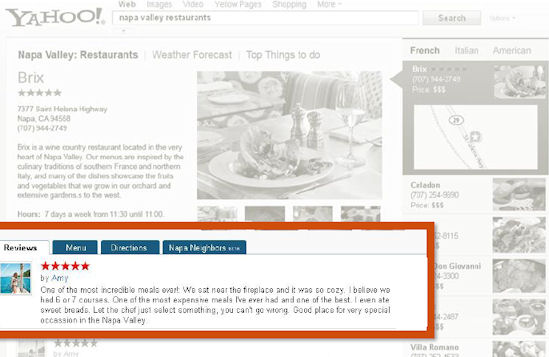 |
Eric Enge: You could argue that you are providing the results for four different searches in the old-fashioned world. Reviews, menu directions, a way to share it, and putting that all into a single answer to the original question.
Shashi Seth: That brings up a good point of how to measure that. Should it be counted as one search or four searches? The world is changing and as we get better at providing answers to user’s needs, the number of queries alone is never going to be a good enough measure of how good of a job someone is doing. One would actually argue the opposite. If a user’s needs can be answered in one query, or without even them asking them a question, how is success measured?
Eric Enge: Maybe another way is to measure the average number of queries per session and if that goes down you are making progress.
Shashi Seth: Yes. User engagement or time spent on a search results page is another. A host of different measurements tell the story significantly better than just the number of queries being performed on a search engine.
Eric Enge: Is Yahoo continuing to invest in mobile search too?
Shashi Seth: Absolutely. We believe that the next frontier of search is definitely in the mobile space. We already do really well in that space with nearly a hundred partnerships with various carriers and OEMs around the world. In recent months we’ve picked two out of the three carriers in Canada as partners. There are countries like Indonesia where we have 80% penetration in the mobile search space. We’ve done an amazing job with it, and today our volume of mobile search is pretty high. In the next five years, mobile search has the opportunity to become larger than web search.
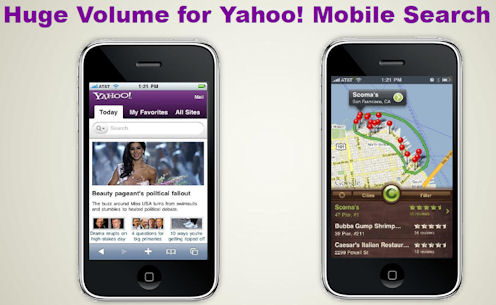 |
For us, mobile search is not about a search box where someone enters a query and gets an answer. We gave people a peek into the future by creating an app called Sketch-a-Search, which we launched on the iPhone.
Essentially the user never has to type a query and we don’t even offer a keyboard in that scenario. It starts with a map and the user simply points out an area that interests them on the map. In San Francisco, they might be looking for restaurants around near them. They simply draw a circle along the road and we find all the restaurants and provide ways to filter the results so they can find exactly what they are looking for. When they find it, we have the contact information, menu and if possible images and reviews, and they never have to type a query.
In the world of Smartphones, people are going to use apps as a proxy for search. They will look at the task at hand, and find an app that fits that need. It will become more vertical as people use it for shopping, local services, restaurants, points of interest, travel, music and so forth, which is quite different from web search. It is much more contextual and location driven.
Eric Enge: Despite the rage about how great mobile devices are, the reality is that the keyboard experience just isn’t the same. People need to have options for discovering information. What do you leverage in the discovery process to personalize the user experience on web or mobile search?
Shashi Seth: We already look at their interests and their demographics for advertising, which is not much different from what is needed to do content targeting or personalization.
Over a period of time, we can determine what someone’s interests are. If they have been looking for a car on Yahoo Search for a week and going to Yahoo Autos and interacting with different modules and content across the network related to automobiles, we have a fair sense that they are interested in researching or purchasing a car. While protecting these details and any personal information, we can target them both from an advertising perspective as well as a content perspective.
A lot of our content optimization and content targeting personalization technologies straddle those worlds really well, so we are able to get to the users and create experiences that make sense for them. It has to be done subtly so as not to be alarming to them. We have learned that art over the years, and have already deployed a good amount of this technology. Of course, we are always improving and making it better.
When we run a test of personalized content and targeted content discovery versus non-targeted content discovery, the numbers speak for themselves. That is a large problem anyways that people like Amazon and others have to grapple with. That science is becoming better and better, and we are seeing the results get significantly better over the months. We have a lot of hope and a lot of excitement in that space.
Eric Enge: Thanks Shashi!
Shashi Seth: Thank you Eric!

